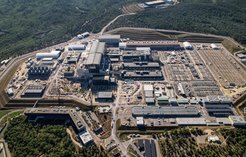The implications of the new ITER schedule
Prof Sibylle Günter, Scientific Director of IPP comments on the delays in the world's largest fusion project
ITER Director-General Pietro Barabaschi, today announced the new baseline for the project. The new timeline envisages that research activities on ITER will start in 2034. It is important to note that the new baseline is not comparable with the original schedule, which envisaged a first plasma as early as 2025. In recent years, it had already become apparent that the previous plan would not be achievable. Pietro Barabaschi cites the COVID-19 pandemic, quality issues and too optimistic planning for such a "first of a kind" project as the reasons for the delay.

What does the new baseline mean for fusion research?
Prof Dr Sibylle Günter, Scientific Director of IPP:
"The ITER management has presented a plan that deals with the serious problems in a very intelligent way. It has not simply postponed the old deadlines, but has re-prioritised and reorganised work steps, which is possible because there are only problems with a small number of components. The plans have also been adapted to the current state of knowledge, so that tungsten is now being used as the material for the first wall instead of beryllium - a development that was only made possible by our research at ASDEX Upgrade. ITER will also have a much stronger plasma heater than originally planned.
Of course, the result still means that the relevant research work on ITER will start later. But the delay is less than we feared. What is important: ITER will start scientific operation in 2034 and will be able to work on deuterium-deuterium plasmas and with full magnetic energy in 2036 - the latter is a delay of three years compared to the original plan. Operation with the relevant fusion fuel deuterium-tritium is scheduled to begin in 2039. That is a delay of four years.
The fact that the start of research activities at ITER has been delayed is a negative signal - but the easiest thing for us researchers to cope with. The ITER facility originally planned for 2025 would have been a very slimmed-down version that would not have reached its full expansion stage until the 2030s anyway. In this respect, it will be all the more important for us to make the best possible preparations for ITER operation with the smaller experimental facilities now available, such as ASDEX Upgrade and the joint European-Japanese experiment JT-60SA.
Do we still need ITER at all, now that there are parallel commercial and government projects that may go into operation more quickly? Yes, definitely. We are not aware of any project that will analyse the challenges as comprehensively as ITER in the foreseeable future. Among other things, we are talking about a power balance of Q=10 and tritium breeding in the wall. ITER has also already achieved ground-breaking engineering work up to this point, which will be important for all the fusion projects now underway and those still to come. They can benefit from the experience gained at ITER. To make this work, the ITER team has started this year to share data and experience intensively with fusion companies.
There has been a lot of good news for nuclear fusion in recent years: Major research successes in magnetic fusion (for example at JET and Wendelstein 7-X) and laser fusion (especially at NIF), new government funding programmes (including in Germany) and the establishment of more than thirty fusion companies worldwide have made headlines. Today's announcement from ITER is no cause for celebration. However, our research will help to minimise the consequences of this delay and we still expect to see positive momentum in the field of nuclear fusion. We are observing the formation of fusion ecosystems with private and state players around the world. Hardly anyone would have predicted such a development just a few years ago."
